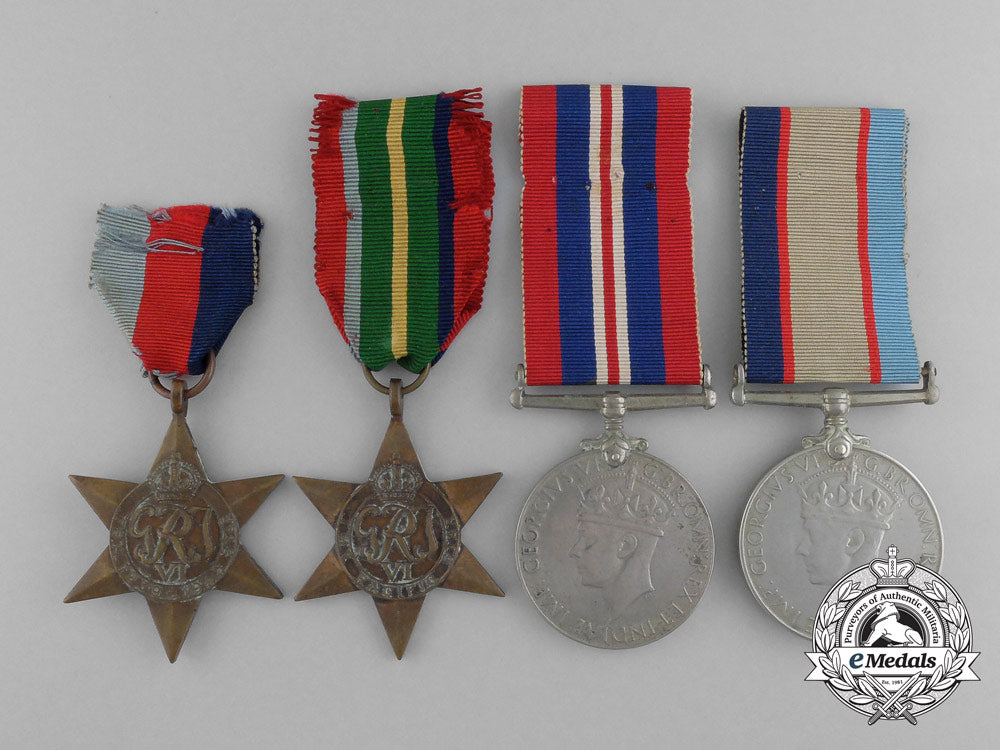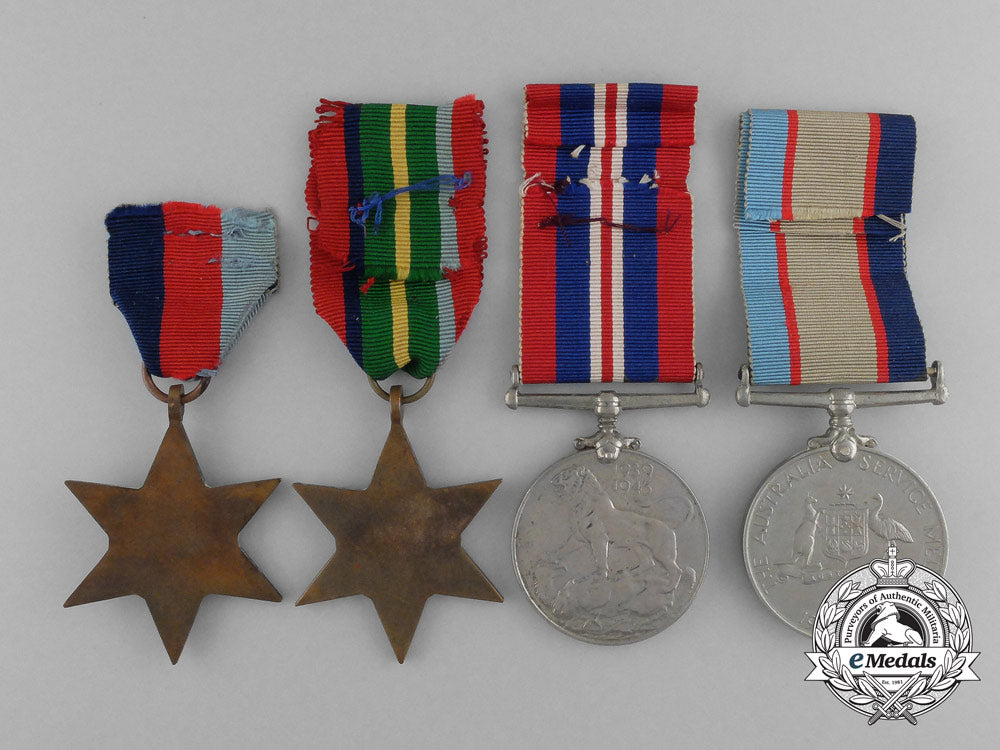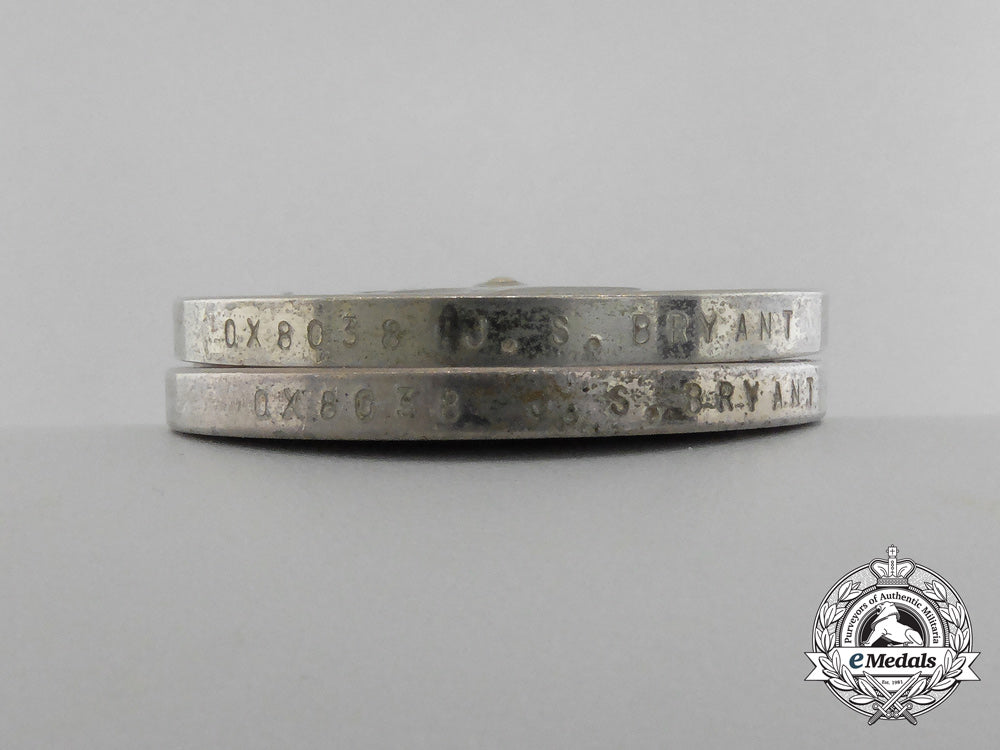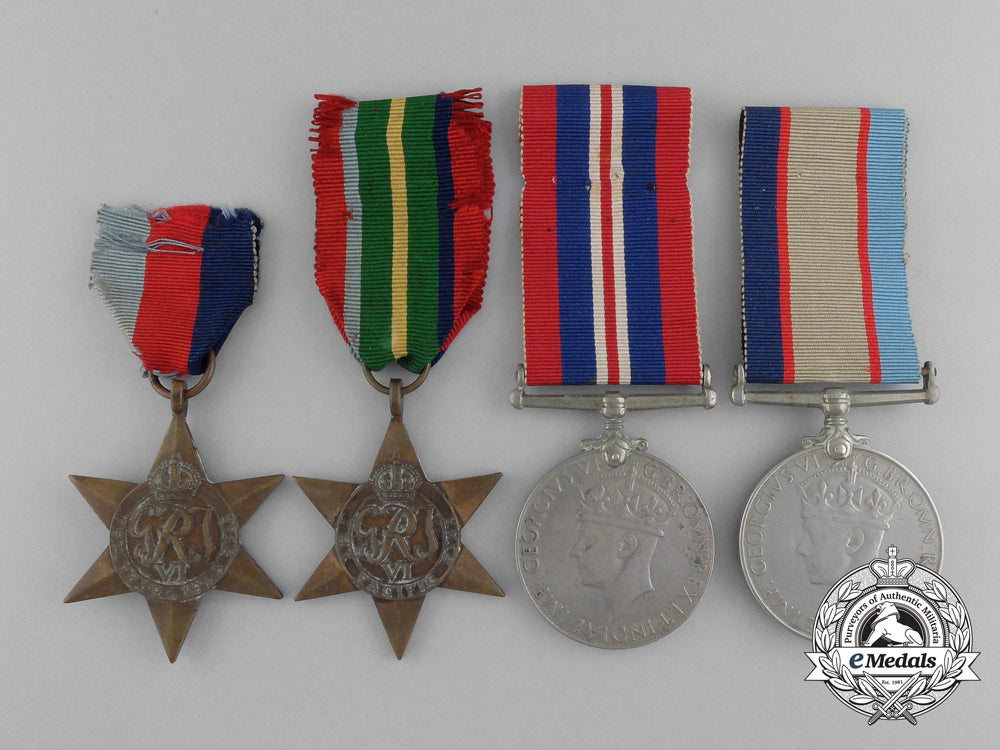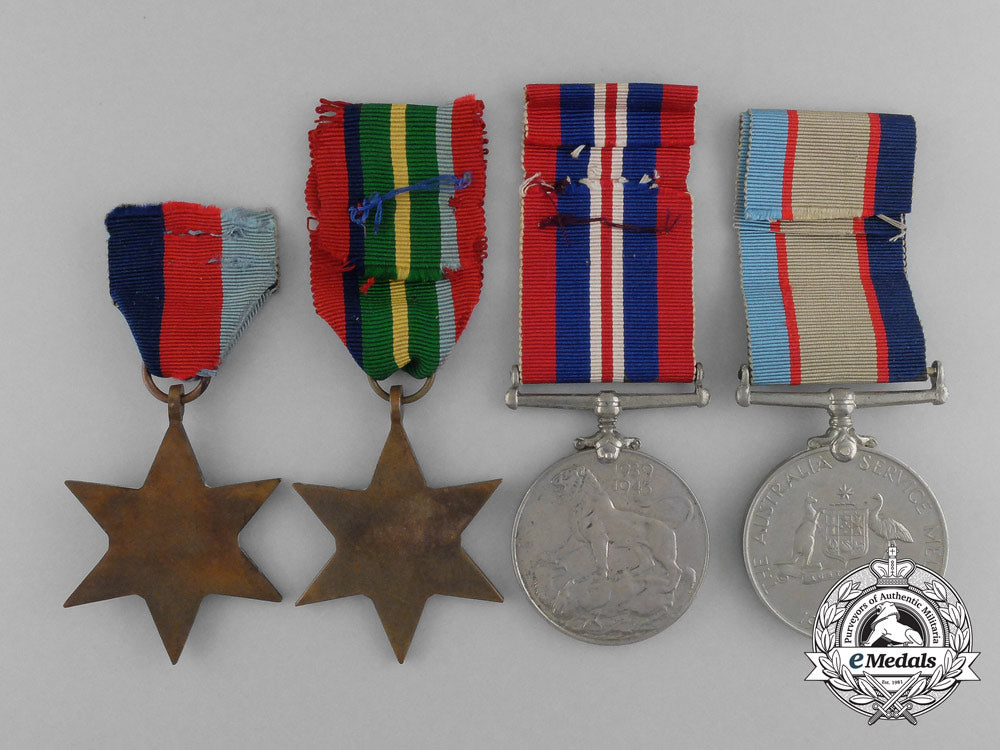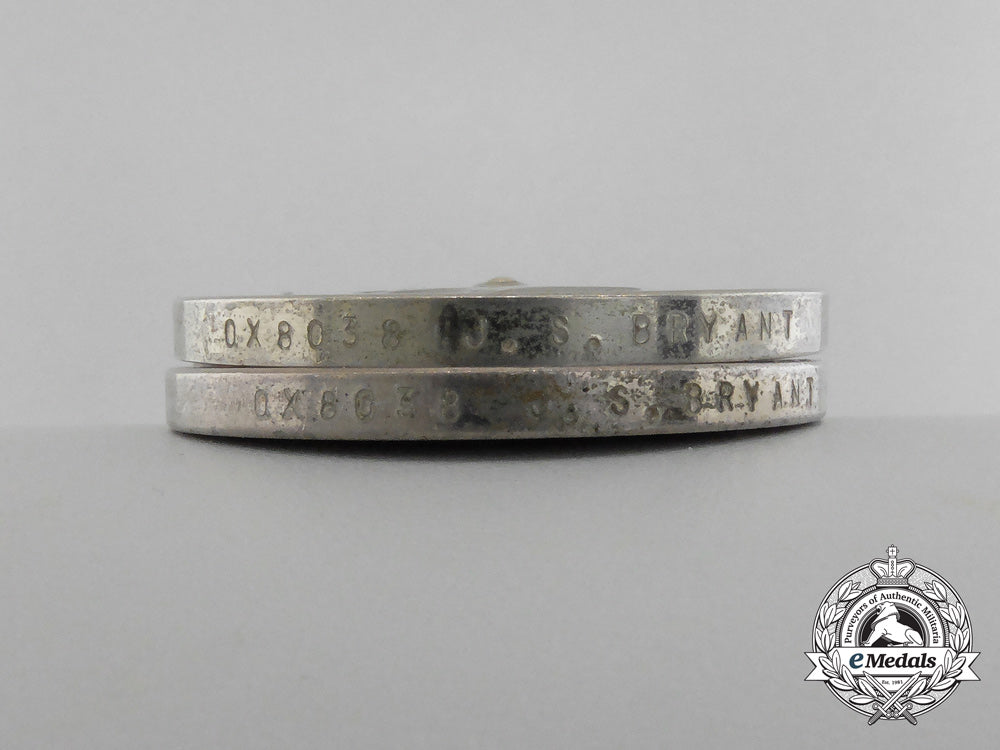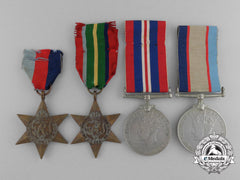
LOADING ...
In response to evolving domestic opinion, eMedals Inc has made the conscious decision to remove the presentation of German Third Reich historical artifacts from our online catalogue. For three decades, eMedals Inc has made an effort to preserve history in all its forms. As historians and researchers, we have managed sensitive articles and materials with the greatest of care and respect for their past and present social context. We acknowledge the growing sentiments put forth by the Canadian public and have taken proactive actions to address this opinion.

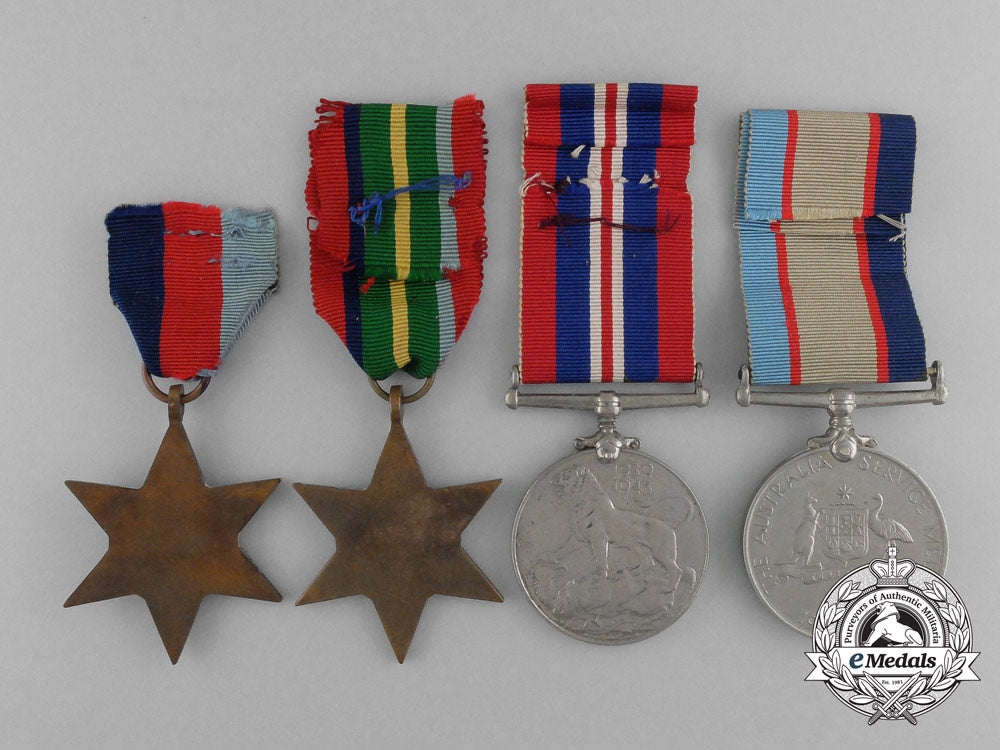
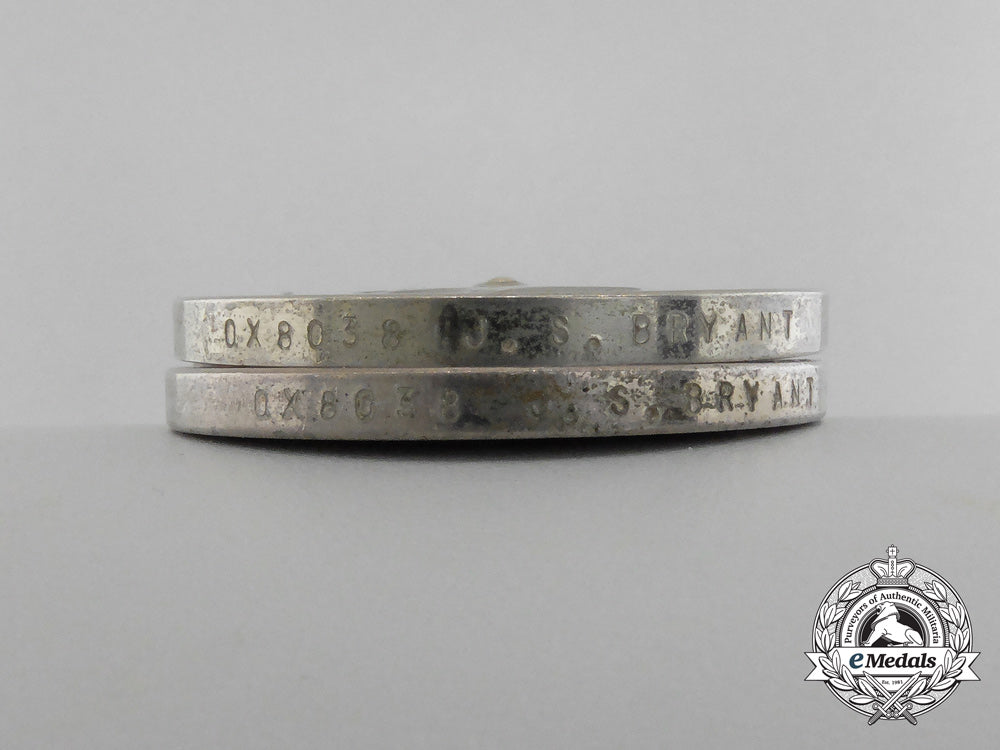
A Second War Group To Sapper James S. Bryant; A Battle Of Ambon Pow
A Second War Group To Sapper James S. Bryant; A Battle Of Ambon Pow
SKU: ITEM: W3996
Current Bid:
Your Max Bid:
Bid History:
Time Remaining:
Couldn't load pickup availability
Shipping Details
Shipping Details
eMedals offers rapid domestic and international shipping. Orders received prior to 12:00pm (EST) will be shipped on the same business day.* Orders placed on Canadian Federal holidays will be dispatched the subsequent business day. Courier tracking numbers are provided for all shipments. All items purchased from eMedals can be returned for a full monetary refund or merchandise credit, providing the criteria presented in our Terms & Conditions are met. *Please note that the addition of a COA may impact dispatch time.
Shipping Details
eMedals offers rapid domestic and international shipping. Orders received prior to 12:00pm (EST) will be shipped on the same business day.* Orders placed on Canadian Federal holidays will be dispatched the subsequent business day. Courier tracking numbers are provided for all shipments. All items purchased from eMedals can be returned for a full monetary refund or merchandise credit, providing the criteria presented in our Terms & Conditions are met. *Please note that the addition of a COA may impact dispatch time.
Description
Description
1939-1945 Star; Pacific Star; War Medal 1939-1945 (QX8038 J.S. BRYANT); and Australia Service Medal 1939-1945 (QX8038 J.S. BRYANT). Naming is officially impressed on the WM and ASM, the Stars are un-named. Un-mounted, original ribbons, residue present in the recessed areas of the Stars from cleaning, scattered green oxidation evident on the reverse of the WM, light contact, very fine. Accompanied by copies of his Service Records.
Footnote: James Stewart Bryant was born on November 20, 1904 in Mount Morgan, Queensland. He was a resident of Mackay, Queensland, when he enlisted with the Australian Imperial Forces (QX8038) at Rockhampton, Queensland on May 20, 1940, at the age of 35, naming his next-of-kin as his father, James Bryant of Yeppone, Queensland (later of Brisbane), stating that he was Single, that his religion was Presbyterian and that his occupation was that of Road Worker. He was posted as a Sapper to the 42nd Military Area with the 2/1st Ordnance Stores, Australian Ordnance Army Corps (AAOC) at Enoggera (Brisbane) on May 24th. He was listed as "sick"at Camp Dressing Station at Redbank (Brisbane) from May 29th to June 1st. He was transferred to the 8th Division, Australian Ordnance Army Corps at Grovely (Brisbane) on July 9th, then posted to the Infantry Training Depot at Lytton (Brisbane) on August 27th. He was reported Absent Without Leave (AWOL) later that year, from October 1st to 2nd. Bryant was transferred to the 2/11th Field Company Engineers on February 5, 1941, then posted to camp at Darwin, Northern Territory via Alice Springs by train and truck, on March 6, 1941, where he was graded Tinsmith III. Bryant embarked Darwin for Ambon in the Dutch East Indies (now Indonesia) on December 13, 1941, aboard the Dutch ship, Both, as part of the 1,100 man battalion known as Gull Force, arriving in Ambon on the 17th. The group comprised the 2/21st Battalion, which was part of the 23rd Brigade, 8th Australian Division, together with anti-tank, engineer, medical and other detachments. Their task was to join Netherlands East Indies troops of about 2,500 men, to help defend the Bay of Ambon and two airfields at Laha and Liang. The Dutch commander, Lieutenant-Colonel J.R.L. Kapitz, was senior to the Australian commander, Lieutenant-Colonel L.N. Roach, and took control of both forces, dispersing them into two groups. One group was sent to defend the airfield at Laha on the west side of Ambon Bay, of which Bryant was part of, while the others were deployed to the east of the bay, south of the town of Ambon. Both the Australian and the Dutch forces were inadequately prepared and under-equipped. Lieutenant-Colonel Roach, aware of the futility of their task, made repeated requests for reinforcements of both men and equipment from Australia, even suggesting that Gull Force should be evacuated from the island, if it could not be reinforced. Instead, he was recalled to Australia and Lieutenant-Colonel John Scott, a 53-year-old Army Headquarters staff officer from Melbourne, replaced Roach as commanding officer of Gull Force in the middle of January. The Japanese landed on the island of Ambon on January 30, 1942. After just four days of bitter fighting the under-equipped and poorly prepared Australian and Dutch forces on the island surrendered. The first Japanese air attack on Ambon occurred on January 6, 1942 and by January 24th, the Japanese were less than 1,000 kilometres from the island. The last of the Allied aircraft were withdrawn on January 30th. The Japanese landed three battalions on Ambon during the night of January 30-31. The Australians lost contact with the Dutch who capitulated the next day, on February 1st. Lieutenant-Colonel Scott, the Australian commander, surrendered two days later on February 3rd. Some small groups of men escaped and made their way back to Australia but almost 800 surviving Australians became prisoners of war, one of which was Bryant. The Australians together with about 300 Dutch prisoners of war were put back into their barracks at Tan Tui (AKA Tan Toey), north of Ambon town. Bryant was listed as Missing in Action (MIA) on February 8th, then reported as a Prisoner of War (POW), likely at Tan Tui, on February 22nd. Almost three months after being reported as a POW, Bryant was reported as a Prisoner of War at Ambon on May 14th. On October 25, 1942, about 500 of the Australian and Dutch prisoners were sent to Hainan, an island in the South China Sea off the coast of mainland China. Led by Lieutenant-Colonel Scott, they left Ambon in the Taiko Maru, a ship designated to carry prisoners of war (AKA known as Japanese "Hell Ships", with extremely unpleasant living conditions or with a reputation for cruelty among the crew) and arrived in the Bay of Sama on Hainan Island onNovember 4th. The next day they sailed up the coast to a camp at Bakli Bay. The Japanese government had recognized Hainan Island's potential and planned to use the POWs to build roads and viaducts, in order to develop agriculture and industry on the island. The prisoners were forced to do hard manual labour under difficult and brutal conditions with a completely inadequate diet. By 1945, the survivors were all starving. Worse still, Scott was an unpopular senior officer who was unable to command the respect of his troops. His unpopularity increased when he organized Japanese, rather than Australian, discipline for men who violated Australian army regulations. Early in 1944, forty of the Australians were sent to work at the Japanese garrison at Hoban, north of Bakli Bay on Hainan. While out on a work party one morning, they were fired on by Chinese guerrillas, some of several thousand nationalist and communist guerillas still operating against the Japanese on the island. Nine Australian POWs were killed, three were wounded and ten others were captured by the guerillas but were never recovered. At the end of August 1945, Americans liberated the POWs from Hainan. On Ambon, the surviving Australian POWs waited another four weeks to be rescued by the Royal Australian Navy corvettes, HMAS Cootamundra, Glenelg, Latrobe and Junee. The very high (over seventy-five percent) death rate on Ambon had been exacerbated when an American bomber dropped six bombs on the Japanese bomb dump right next to the Tan Tui POW camp. The dump ignited and exploded, killing six Australian officers, including the doctor, four other ranks and twenty-seven Dutch women and children. A number of Dutch and Australian casualties died later. After the Japanese surrender, it was discovered that about 300 servicemen who had surrendered at Laha airfield had been killed in four separate massacres between February 6 and 20, 1942. Not one had survived. The prisoners on Ambon and Hainan were subjected to some of the most brutal treatment experienced by POWs anywhere during the Second World War. Over three-quarters of the Australian prisoners there died in captivity. Although no definitive date is stated, Byant was liberated, as advised by the Australian Legation at Chungking (now Chongqing), China. He embarked Manila, Philippines aboard the Attacker class escort carrier HMS Striker on September 27, 1945, disembarking in Sydney on October 9th. He was hospitalized for thirty-two days at 102nd General Hospital from November 8 to December 10, 1945, with Dyspepsia (also known as indigestion, is a condition of impaired digestion. Symptoms may include upper abdominal fullness, heartburn, nausea, belching, or upper abdominal pain. People may also experience feeling full earlier than expected when eating. Dyspepsia is a common problem and is frequently caused by gastroesophageal reflux disease (GERD) or gastritis. In a small minority it may be the first symptom of peptic ulcer disease (an ulcer of the stomach or duodenum) and occasionally cancer). Sapper James Stewart Bryant was posted to the 2nd Battalion, 11th Field Company when he was discharged from active service at Brisbane on December 17, 1945. For his Second World War service, Bryant was awarded the 1939-1945 Star, the Pacific Star, the War Medal 1939-1945 and the Australia Service Medal 1939-1945. He died on April 26, 1973, at the age of 68.
Description
1939-1945 Star; Pacific Star; War Medal 1939-1945 (QX8038 J.S. BRYANT); and Australia Service Medal 1939-1945 (QX8038 J.S. BRYANT). Naming is officially impressed on the WM and ASM, the Stars are un-named. Un-mounted, original ribbons, residue present in the recessed areas of the Stars from cleaning, scattered green oxidation evident on the reverse of the WM, light contact, very fine. Accompanied by copies of his Service Records.
Footnote: James Stewart Bryant was born on November 20, 1904 in Mount Morgan, Queensland. He was a resident of Mackay, Queensland, when he enlisted with the Australian Imperial Forces (QX8038) at Rockhampton, Queensland on May 20, 1940, at the age of 35, naming his next-of-kin as his father, James Bryant of Yeppone, Queensland (later of Brisbane), stating that he was Single, that his religion was Presbyterian and that his occupation was that of Road Worker. He was posted as a Sapper to the 42nd Military Area with the 2/1st Ordnance Stores, Australian Ordnance Army Corps (AAOC) at Enoggera (Brisbane) on May 24th. He was listed as "sick"at Camp Dressing Station at Redbank (Brisbane) from May 29th to June 1st. He was transferred to the 8th Division, Australian Ordnance Army Corps at Grovely (Brisbane) on July 9th, then posted to the Infantry Training Depot at Lytton (Brisbane) on August 27th. He was reported Absent Without Leave (AWOL) later that year, from October 1st to 2nd. Bryant was transferred to the 2/11th Field Company Engineers on February 5, 1941, then posted to camp at Darwin, Northern Territory via Alice Springs by train and truck, on March 6, 1941, where he was graded Tinsmith III. Bryant embarked Darwin for Ambon in the Dutch East Indies (now Indonesia) on December 13, 1941, aboard the Dutch ship, Both, as part of the 1,100 man battalion known as Gull Force, arriving in Ambon on the 17th. The group comprised the 2/21st Battalion, which was part of the 23rd Brigade, 8th Australian Division, together with anti-tank, engineer, medical and other detachments. Their task was to join Netherlands East Indies troops of about 2,500 men, to help defend the Bay of Ambon and two airfields at Laha and Liang. The Dutch commander, Lieutenant-Colonel J.R.L. Kapitz, was senior to the Australian commander, Lieutenant-Colonel L.N. Roach, and took control of both forces, dispersing them into two groups. One group was sent to defend the airfield at Laha on the west side of Ambon Bay, of which Bryant was part of, while the others were deployed to the east of the bay, south of the town of Ambon. Both the Australian and the Dutch forces were inadequately prepared and under-equipped. Lieutenant-Colonel Roach, aware of the futility of their task, made repeated requests for reinforcements of both men and equipment from Australia, even suggesting that Gull Force should be evacuated from the island, if it could not be reinforced. Instead, he was recalled to Australia and Lieutenant-Colonel John Scott, a 53-year-old Army Headquarters staff officer from Melbourne, replaced Roach as commanding officer of Gull Force in the middle of January. The Japanese landed on the island of Ambon on January 30, 1942. After just four days of bitter fighting the under-equipped and poorly prepared Australian and Dutch forces on the island surrendered. The first Japanese air attack on Ambon occurred on January 6, 1942 and by January 24th, the Japanese were less than 1,000 kilometres from the island. The last of the Allied aircraft were withdrawn on January 30th. The Japanese landed three battalions on Ambon during the night of January 30-31. The Australians lost contact with the Dutch who capitulated the next day, on February 1st. Lieutenant-Colonel Scott, the Australian commander, surrendered two days later on February 3rd. Some small groups of men escaped and made their way back to Australia but almost 800 surviving Australians became prisoners of war, one of which was Bryant. The Australians together with about 300 Dutch prisoners of war were put back into their barracks at Tan Tui (AKA Tan Toey), north of Ambon town. Bryant was listed as Missing in Action (MIA) on February 8th, then reported as a Prisoner of War (POW), likely at Tan Tui, on February 22nd. Almost three months after being reported as a POW, Bryant was reported as a Prisoner of War at Ambon on May 14th. On October 25, 1942, about 500 of the Australian and Dutch prisoners were sent to Hainan, an island in the South China Sea off the coast of mainland China. Led by Lieutenant-Colonel Scott, they left Ambon in the Taiko Maru, a ship designated to carry prisoners of war (AKA known as Japanese "Hell Ships", with extremely unpleasant living conditions or with a reputation for cruelty among the crew) and arrived in the Bay of Sama on Hainan Island onNovember 4th. The next day they sailed up the coast to a camp at Bakli Bay. The Japanese government had recognized Hainan Island's potential and planned to use the POWs to build roads and viaducts, in order to develop agriculture and industry on the island. The prisoners were forced to do hard manual labour under difficult and brutal conditions with a completely inadequate diet. By 1945, the survivors were all starving. Worse still, Scott was an unpopular senior officer who was unable to command the respect of his troops. His unpopularity increased when he organized Japanese, rather than Australian, discipline for men who violated Australian army regulations. Early in 1944, forty of the Australians were sent to work at the Japanese garrison at Hoban, north of Bakli Bay on Hainan. While out on a work party one morning, they were fired on by Chinese guerrillas, some of several thousand nationalist and communist guerillas still operating against the Japanese on the island. Nine Australian POWs were killed, three were wounded and ten others were captured by the guerillas but were never recovered. At the end of August 1945, Americans liberated the POWs from Hainan. On Ambon, the surviving Australian POWs waited another four weeks to be rescued by the Royal Australian Navy corvettes, HMAS Cootamundra, Glenelg, Latrobe and Junee. The very high (over seventy-five percent) death rate on Ambon had been exacerbated when an American bomber dropped six bombs on the Japanese bomb dump right next to the Tan Tui POW camp. The dump ignited and exploded, killing six Australian officers, including the doctor, four other ranks and twenty-seven Dutch women and children. A number of Dutch and Australian casualties died later. After the Japanese surrender, it was discovered that about 300 servicemen who had surrendered at Laha airfield had been killed in four separate massacres between February 6 and 20, 1942. Not one had survived. The prisoners on Ambon and Hainan were subjected to some of the most brutal treatment experienced by POWs anywhere during the Second World War. Over three-quarters of the Australian prisoners there died in captivity. Although no definitive date is stated, Byant was liberated, as advised by the Australian Legation at Chungking (now Chongqing), China. He embarked Manila, Philippines aboard the Attacker class escort carrier HMS Striker on September 27, 1945, disembarking in Sydney on October 9th. He was hospitalized for thirty-two days at 102nd General Hospital from November 8 to December 10, 1945, with Dyspepsia (also known as indigestion, is a condition of impaired digestion. Symptoms may include upper abdominal fullness, heartburn, nausea, belching, or upper abdominal pain. People may also experience feeling full earlier than expected when eating. Dyspepsia is a common problem and is frequently caused by gastroesophageal reflux disease (GERD) or gastritis. In a small minority it may be the first symptom of peptic ulcer disease (an ulcer of the stomach or duodenum) and occasionally cancer). Sapper James Stewart Bryant was posted to the 2nd Battalion, 11th Field Company when he was discharged from active service at Brisbane on December 17, 1945. For his Second World War service, Bryant was awarded the 1939-1945 Star, the Pacific Star, the War Medal 1939-1945 and the Australia Service Medal 1939-1945. He died on April 26, 1973, at the age of 68.
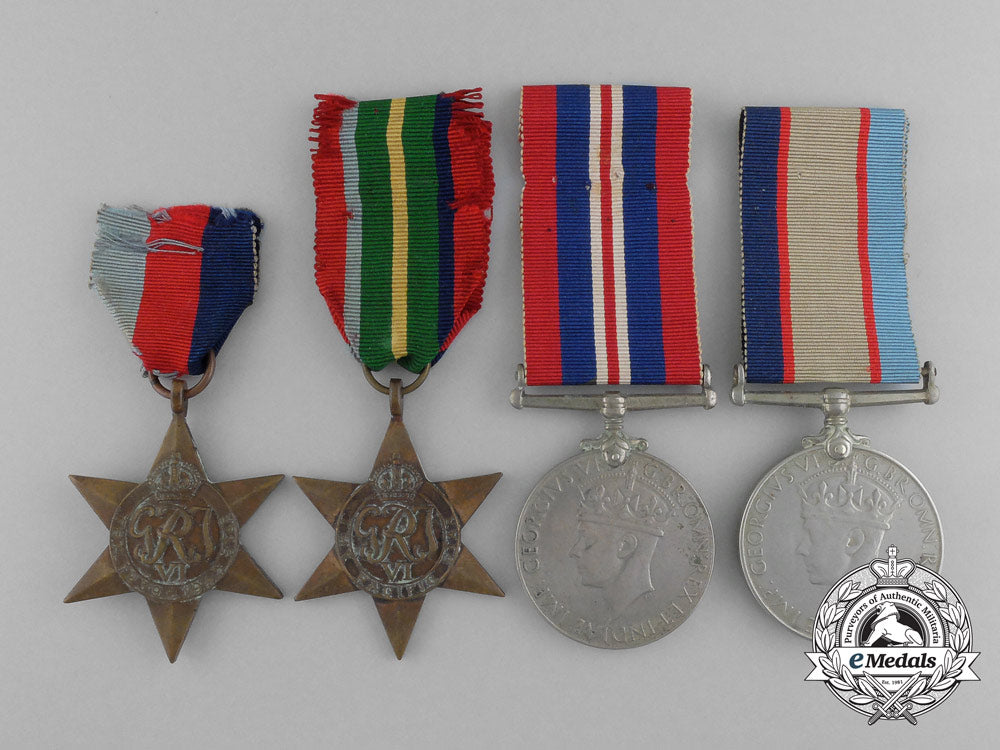
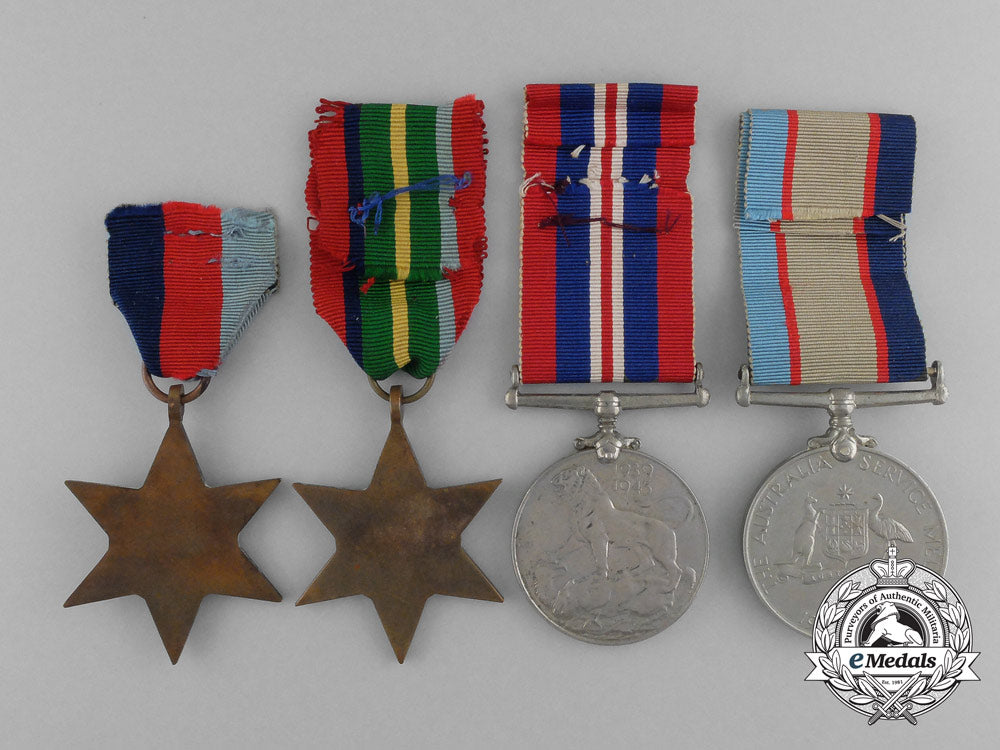
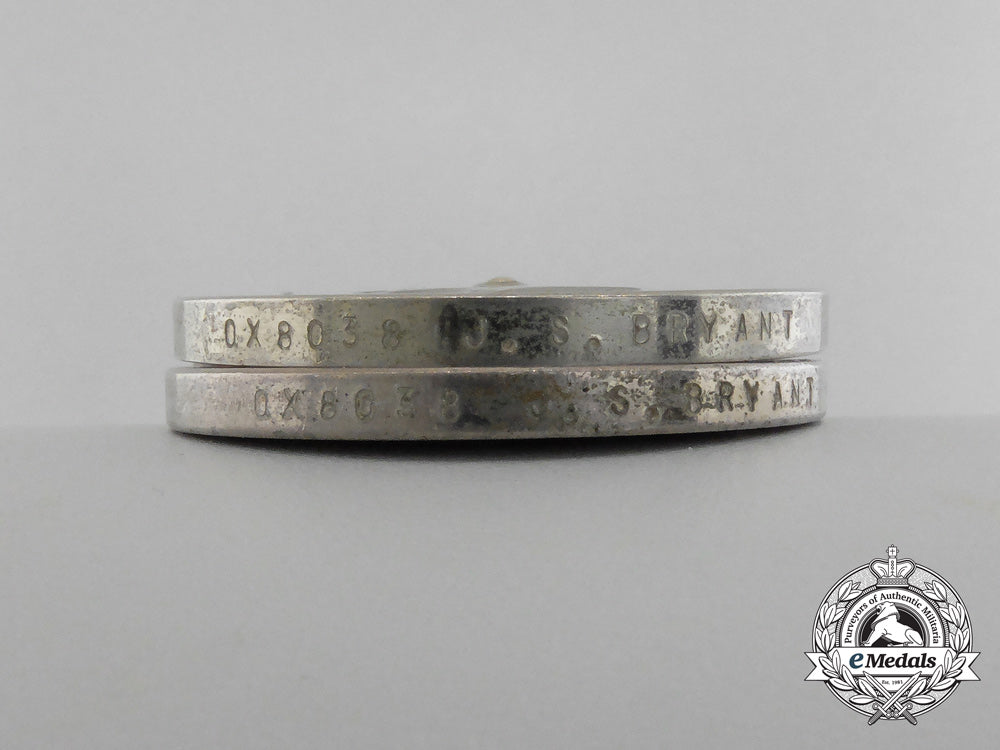
You May Also Like
Germany, Third Reich. A Mixed Lot of Tyrolean Marksmanship Badges
G52930
Germany, SS. An Estonian Waffen-SS Volunteer’s Sleeve Shield
G50381
Germany, SS. A Waffen-SS Sturmmann Sleeve Insignia
G52846
Germany, Third Reich; Slovakia, First Republic. A Mixed Lot of Wartime Postcards
G52905
Germany, Third Reich. A Pair of Tyrolean Marksmanship Badges
G52981
-
Germany, Third Reich. A Mixed Lot of Tyrolean Marksmanship Badges
G52930
Add to CartRegular price $135 USDRegular price $0 USD Sale price $135 USDUnit price / per -
Germany, SS. An Estonian Waffen-SS Volunteer’s Sleeve Shield
G50381
Add to CartRegular price $150 USDRegular price $0 USD Sale price $150 USDUnit price / per -
Germany, SS. A Waffen-SS Sturmmann Sleeve Insignia
G52846
Add to CartRegular price $135 USDRegular price $0 USD Sale price $135 USDUnit price / per -
Germany, Third Reich; Slovakia, First Republic. A Mixed Lot of Wartime Postcards
G52905
Add to CartRegular price $135 USDRegular price $0 USD Sale price $135 USDUnit price / per -
Germany, Third Reich. A Pair of Tyrolean Marksmanship Badges
G52981
Add to CartRegular price $135 USDRegular price $0 USD Sale price $135 USDUnit price / per
Do you have a similar item you are interested in selling?
Please complete the form and our client care representatives will contact you.
Sell Item